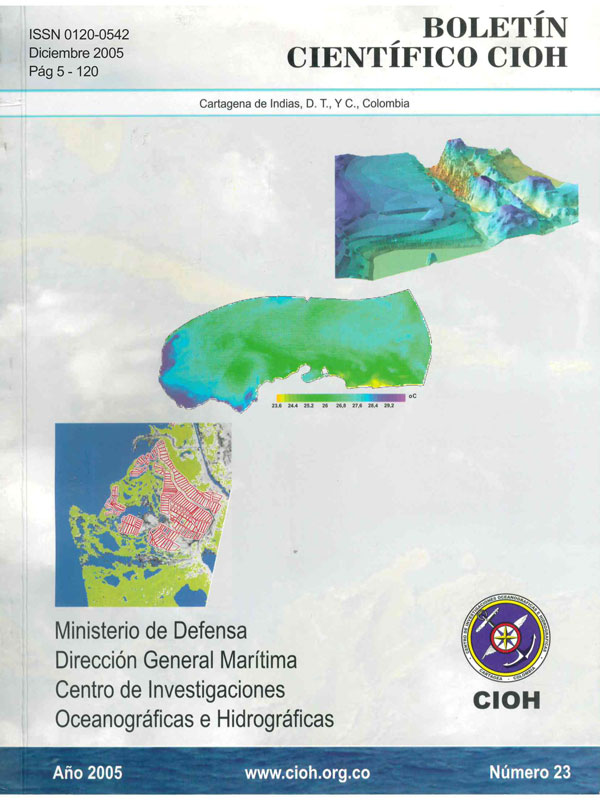Determinación del clima de oleaje medio y extremal en el Caribe colombiano
DOI:
https://doi.org/10.26640/22159045.137Keywords:
Wave, Caribbean, hurricane, regimes, ColombiaAbstract
The present article presents the equations for the wave visual data correction. These equations were obtained by comparison between both, visual data and instrumental data from a scalar wave buoy. Later, it presents a methodology for the generation of waves using the information from tropical storms in the Caribbean Sea. For that, we used data of wind velocity measured by satellites. Finally, the regimes of waves were obtained.Downloads
References
Banton, J. D. (2002). Parametric Models and Methods of Hindcast Analysis for Hurricane Waves. IHE/Alkyon. MSc.Thesis Report.
Calverly, M. J., D. Szabo, V. J. Cardone, E. A.Orelup y M. J. Parsons (2002). Wave climate study of the Caribbean Sea.Proceedings of 7th International Workshop on Wave Hindcasting and Forecasting.
Cooper, C. K. (1988). Parametric Models of Hurricane-Generated Winds, Waves and Currents in Deep Water. Proceedings of 20th Annual OTC, Houston, Texas, USA. pp 475-484.
Dirección General de Puertos de España (1991). Estudio sobre las observaciones visuales de barcos en ruta del N.C.D.C. Programa de Clima Marítimo. (46).
Goda, Y. (1988). On the Methodology of Selecting Design Wave Height. Proceedings of the 21st International Conference in Coastal Engineering. pp. 899-913.
Hogben, N. y F. Lumb (1967). Ocean Wave Statistics. National Physical Laboratory. HMSO, London, United Kingdom.
Hsu, S. A., Jr. M. F. Martin, B. W. Blanchard(2000). An evaluation of the USACE’s deep water wave prediction techniques under hurricane conditions during Georges in 1998. Journal of Coastal Research. 16, (3), pp.823–829.
Hsu, S. A., Z. Yan (1998). A note on the radiusof maximum wind for hurricanes. Journal of Coastal Research. 14, pp. 667–668.
Jardine, T. P. (1977). The reliability of visually observed wave heights. Coastal Engineering, 3, pp. 33-38.
Kumar, V. S., S. Mandal, K. A. Kumar (2003).Estimation of Wind Speed and Wave Heigth during Cyclones. Ocean Engineering, 30, pp. 2239-2253.
Ochi, M. K. (1998). Ocean Waves - The Stochastic Approach. Cambridge Ocean Technology Series, Cambridge University Press, Cambridge, United Kingdom.
Smith, D., P. Warner, J. Banton (2002). Long Term Variability of Hurricane Trends anda Monte Carlo Approach to Design. Proceedings of the International Conference in Coastal Engineering. pp 34-38.
Tejada, C. E. (2002). Clima marítimo de la bahía de Tumaco, un caso de aplicación del sistema de modelado integral de zonas costeras para Colombia. Tesina de Máster. Universidad de Cantabria.
Tejada, C. E., M. González, L. Otero (2004). Desarrollo de un módulo informático para el manejo de datos de oleaje visual para las Aguas Jurisdiccionales colombianas. XXI Congreso Latinoamericano de Hidráulica, Sao Pedro (Brasil).
USACE (1984). Shore Protection Manual. U.S. Army Corps of Engineers, Coastal Engineering Research Center (CERC), Vicksburg, Mississippi, 2 vols.
Young, I. R. (1988). Parametric Wave Prediction Model. Journal of Waterways, Ports, Coastal and Ocean Engineering, 114,(5), pp. 637-652.
Young, I. R. and Burchell, G. P. (1996).Hurricane Generated Waves as Observed by Satellite. Ocean Engineering, 23, (8), pp. 761-776.
Downloads
Published
Issue
Section
License
Attribution — You must give appropriate credit, provide a link to the license, and indicate if changes were made. You may do so in any reasonable manner, but not in any way that suggests the licensor endorses you or your use.
NonCommercial — You may not use the material for commercial purposes.
NoDerivatives — If you remix, transform, or build upon the material, you may not distribute the modified material.
No additional restrictions — You may not apply legal terms or technological measures that legally restrict others from doing anything the license permits.



